- The physical environment influences an organism’s ecological success in two ways:
- Availability of energy and resources—impacts growth and reproduction.
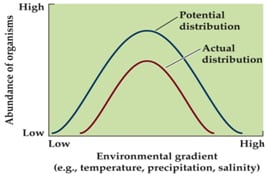
- Extreme conditions can exceed tolerance limits and impact survival.
- Energy supply can influence an organism’s ability to tolerate environmental extremes.
- The actual geographic distribution of a species is often lower than potential distribution due to other factors, such as disturbance and competition.
- Because plants don’t move, they are good indicators of the physical environment.
- Example: Aspen distribution can be predicted based on climate. Low temperatures and drought affect reproduction and survival.
- Physiological ecology is the study of interactions between organisms and the physical environments that influence their survival and persistence.
- Physiological processes have optimal conditions for functioning.
- Deviations from the optimum reduce the rate of the process.
- Stress—environmental change results in decreased rates of physiological processes, lowering the potential for survival, growth, or reproduction. (not same as distrubence)
- Acclimatization: Adjusting to stress through behavior or physiology. (to reach Optimum level)
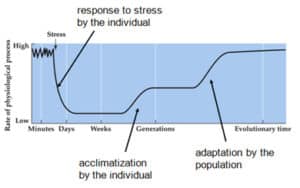
- It is usually a short-term, reversible process.
- Acclimatization to high elevations involves higher breathing rates, greater production of red blood cells, and higher pulmonary blood pressure.
- Over time, individuals will acclimate but it will level off and then natural selection can result in adaptation of a population to environmental stress.
- Individuals with traits that enable them to cope with stress are favored.
- Over time, these genetic traits become more frequent in the population and could return to Optimum level under need environment and stress
- Ecotypes: Populations with adaptations to unique environments.
- Ecotypes can eventually become separate species as populations diverge and become reproductively isolated.
- Acclimatization and adaptation require investments of energy and resources, representing possible trade-offs with other functions that can also affect survival and reproduction.
Temperature Stress
- Environmental temperatures vary greatly throughout the biosphere.
- Survival and functioning of organisms is strongly tied to their internal temperature.
- Some archaea and bacteria in hot springs can function at 90°C.
- Lower limits are determined by temperature at which water freezes in cells (–2 to –5°C).
- Endotherms are unable to function at extremely high and low temperature ranges
- Metabolic reactions are catalyzed by enzymes, which have narrow temperature ranges for optimal function.
- At high temperatures, enzymes become denatured, which destroys enzyme function.
- Some species produce different forms of enzymes (isozymes) with different temperature optima that allow acclimatization to changing conditions, such as seasonal temperature change.
- Temperature also affects the properties of cell membranes, which are composed of two layers of lipid molecules.
- At low temperatures, these lipids can solidify, embedded proteins can’t function, and the cells leak metabolites.
- Plants that thrive at low temperatures have higher proportions of unsaturated lipids (with double bonds) in their cell membranes
- Animals such as birds and mammals can generate heat internally.
- Generating heat internally is an advantage:
- These animals can maintain relatively constant internal temperatures near the optimum for metabolic functions under a wide range of external temperatures.
- These animals can extend their geographic range.
- Ectotherms: Regulate body temperature through energy exchange with the external environment.
- Endotherms: Rely primarily on internal heat generation—mostly birds and mammals.
- Some other organisms that generate heat internally include bees, some fish, such as tuna, and even some plants.
- Ectotherm surface area-to-volume ratio of the body is an important factor in exchanging energy with the environment. (
- A larger surface area allows greater heat exchange, but makes it harder to maintain internal temperature.
- A smaller surface area relative to volume decreases the animal’s ability to gain or lose heat.
- As body size increases, surface area-to-volume ratio decreases, and large ectotherms are thus improbable.
- This led to speculation that large dinosaurs may have had some degree of endothermy.
- Small aquatic ectotherms remain the same temperature as the water.
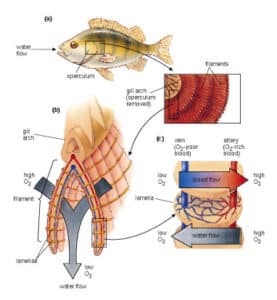
- Some large ectotherms can maintain higher body temperature:
- Many terrestrial ectotherms can move around to adjust temperature.
- Many insects and reptiles bask in the sun to warm up after a cold night. Because this increases risk from predators, many are camouflaged and can change coloration to match backgrounds.
- Ectotherms in temperate and polar regions must avoid or tolerate freezing.
- Avoidance behavior includes seasonal migration to lower latitudes or to microsites that are above freezing (e.g., burrows in soil, moving around, sun exposure).
- Tolerance to freezing involves minimizing damage associated with ice formation in cells.
- Some insects have high concentrations of glycerol, a chemical that lowers the freezing point of body fluids.
- Vertebrates generally do not tolerate freezing temperatures.
- Cryonics is the preservation of bodies by freezing, in hope that they can be brought back to life in the future.
- Only a few vertebrates can withstand freezing.
- In most organisms, freezing results in tissue damage as ice crystals perforate cell membranes and organelles.
- In animals that withstand freezing, the freezing water is limited to the space outside the cells.
- Ice-nucleating proteins outside cells serve as sites of slow, controlled ice formation.
- Additional solutes, such as glucose and glycerol are made inside the cells to lower the freezing point.
- Endotherms can remain active at subfreezing temperatures.
- The cost of being endothermic is a high demand for energy (food) to support metabolic heat production.
- Metabolic rates are a function of the external temperature and rate of heat loss.
- Rate of heat loss is related to body size and surface area-to-volume ratio.
- Small endotherms with large surface area-to-volume ratio have higher metabolic rates, and require more energy and higher feeding rates than large endotherms.
- Thermoneutral zone: The range of environmental temperatures over which a constant basal metabolic rate can be
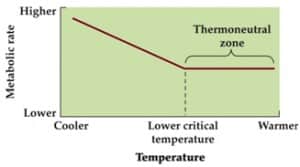 maintained. As temperature degrees, basal metabolic rates increases
maintained. As temperature degrees, basal metabolic rates increases - Lower critical temperature: When heat loss is greater than metabolic production; body temperature drops and metabolic heat generation increases.
- Mammals in the Arctic have lower critical temperatures than mammals in tropical regions.
- The rate of metabolic activity increases more rapidly below the lower critical temperature in tropical mammals as compared to Arctic mammals.
- Evolution of endothermy required insulation—feathers, fur, and fat.
- Insulation limits conductive and convective heat loss.
- Fur and feathers provide a layer of still air adjacent to the skin. Some animals grow thicker fur for winter.
- Some organisms can survive periods of extreme heat or cold by entering a state of dormancy, in which little or no metabolic activity occurs.
- Small mammals have thin fur and not much fat for energy storage, but high demand for metabolic energy below the lower critical temperature.
- They survive in cold climates by entering a dormant state called torpor. Body temperature and basal metabolic rates are low, which conserves energy. Could be overnight or a couple weeks.
- Energy reserves are needed to come out of torpor. Small endotherms may undergo daily torpor to survive cold nights.
- Longer periods of torpor, or hibernation, are possible for animals that can store enough energy.
Heat Stress Animals
- Some organisms use behavioral changes to control exchange of energy with the environment.
- Examples: Elephants swim and spray water onto their backs with their trunks to cool their bodies.
- Moving into the shade reduces the amount of solar radiation received. Evaporative heat loss in animals includes sweating in humans, panting in dogs and other animals, and licking of the body by some marsupials.
- Ectotherms in hot environments can gain too much heat from the environment and body temperature can reach lethal levels.
- Climate change appears to be limiting the foraging periods of several species of Mexican lizards, whose abundances have decreased significantly.
Water Stress
- Arid conditions are a widespread challenge for organisms.
- Some tolerate dry conditions by going into suspended animation. Many microorganisms do this, as do some multicellular organisms.
- Desiccation-tolerant organisms can lose 80%–90% of their water.
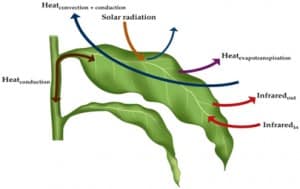
- Water Loss: Rodents/Birds < Human < Camels < Insects
- Reptiles are very successful in dry environments. They have thick skin with layers of dead cells, fatty coatings, and plates or scales.
- Mammals and birds have thick skin plus fur or feathers to minimize water loss.
- Sweat glands in mammals are a trade-off between water loss resistance and evaporative cooling.
- Plants can adjust energy inputs and outputs.
- Transpiration rates can be controlled by
- Specialized guard cells surrounding leaf openings called stomates.
- Variation in degree of opening and number of stomates control the rate of transpiration and thus leaf temperature.
- If soil water is limited, transpirational cooling is not a good mechanism.
- Some plants shed their leaves during dry seasons.
- Other mechanisms include pubescence—hairs on leaf surfaces that reflect solar energy. But hairs also reduce conductive heat loss.
- Pubescence was studied in three Encelia species (plants in the daisy family).
- Desert species with high pubescence were compared with non-pubescent species from wetter, cooler habitats.
- Plants of all three species were grown in both locations (common gardens).
- In the cool, moist location, the three species showed few differences in leaf temperature and stomatal opening.
- In the desert, species with no hairs maintained leaf temperature by transpiration; the pubescent species leaves reflected about twice as much solar radiation.
- If air temperature is lower than leaf temperature, heat can be lost by convection.
- Convective heat loss is related to speed of air moving across a leaf surface.
- Boundary layer: A zone of turbulent flow due to friction, next to the leaf surface.
- The boundary layer lowers convective heat loss. Due to turbulence
- Boundary layer thickness is related to leaf size and surface roughness.
- Small, smooth leaves have thin boundary layers and lose more heat than large or rough leaves.
- In cold, windy environments, convection is the main heat loss mechanism.
- Most alpine plants hug the ground surface to avoid high wind velocities.
- Some have a layer of insulating hair to lower convective heat loss.
